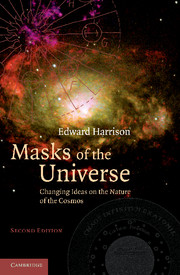Book contents
- Frontmatter
- Contents
- Prefece
- 1 Introducing the Masks
- Part I Worlds in the Making
- Part II The Heart Divine
- 8 Dance of the Atoms and Waves
- 9 Fabric of Space and Time
- 10 What Then is Time?
- 11 Nearer to the Heart's Desire
- 12 The Cosmic Tide
- 13 Do Dreams Come True?
- Part III The Cloud of Unknowing
- Bibliography
- Index
11 - Nearer to the Heart's Desire
Published online by Cambridge University Press: 27 October 2009
- Frontmatter
- Contents
- Prefece
- 1 Introducing the Masks
- Part I Worlds in the Making
- Part II The Heart Divine
- 8 Dance of the Atoms and Waves
- 9 Fabric of Space and Time
- 10 What Then is Time?
- 11 Nearer to the Heart's Desire
- 12 The Cosmic Tide
- 13 Do Dreams Come True?
- Part III The Cloud of Unknowing
- Bibliography
- Index
Summary
We have a picture of a seamless spacetime projecting into the space and time of each observer's world line. Though elegant and economic, in one sense it differs little from the Newtonian picture. Space in the Newtonian scheme was just a sort of nothing (a sideless box) spanning everything, and time was a similar sort of nothing in which everything also had location. In the theory of special relativity both came together to form an expanse of spacetime containing everything that again was just a sort of nothing (just a bigger sideless box).
Then in 1916 Einstein advanced the theory of general relativity and the picture changed dramatically. (How dramatically was not fully realized for many years.) Spacetime lost its state of nothingness and acquired a tangible physical reality. Gravity ceased to be a mysterious astral force acting instantaneously at a distance and became a property of dynamic curved spacetime.
In the new scheme spacetime itself guides the heavenly bodies and the old astrological action at a distance turned out to be the curvature of space and time combined into spacetime. We now have a spacetime that pulls and pushes and transmits shivers and shakes at the speed of light. We cannot eat spacetime, but it can be hit, and can hit back, and can eat us if we stray too close to a black hole. Spacetime in general relativity springs to life and becomes an active participant in the physical universe.
- Type
- Chapter
- Information
- Masks of the UniverseChanging Ideas on the Nature of the Cosmos, pp. 173 - 192Publisher: Cambridge University PressPrint publication year: 2003



